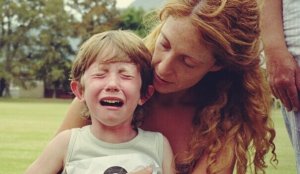Reactive Attachment Disorder: Don't Touch Me!

It’s strange when a child doesn’t seek out any kind of contact and actually avoids it as if their parents were literally fire. No child is born with that attitude; it’s something that they grow into based on the environment they’re in. In these cases they’ve probably been in a completely unstructured environment that’s toxic for them.
“A child’s prior history is what will condition the way they feel in the world and what people expect from them.”
-[Translation] Charo Blanco-

What environments lead to reactive attachment disorder?
When we talk about reactive attachment disorder, we’re talking about a setting that isn’t taking care of a child’s basic needs. These needs can be anything:
- security
- protection
- healthy contact with other people
- eating
- sleeping
- lack of pain
An example of this would be parents who don’t look after their child when they cry out of hunger or the cold. In a certain way, they’re telling their child that the sign of help they’re sending them is useless.
They don’t pay attention to their child’s most basic demands. That’s why their child ends up with an attitude where they don’t waste energy on crying. This improves the chances they’ll survive in the environment they’re stuck with. But what other situations can lead to the disorder?
Environments that can lead to reactive attachment disorder
- Guardians without good parental skills: they aren’t prepared or confident. They have no idea what to do, and make no effort to get better or learn more. They just stick to what they already know.
- Guardians who don’t express their feelings: no one has showed them how to express their emotions. Or maybe traumatic experiences have made them do the opposite: they bottle their emotions up. The result is that they don’t know how to show their affection. They don’t know how to express their love for their child, so their child never feels it.
- Physical or psychological violence: we’re specifically talking about violence from their guardians. It could be physical violence against the child or even sexual abuse.
- Orphans: going between very different guardians or growing up in an orphanage can mean that no one ever takes care of their needs. That usually leads to insecurity and a feeling of abandonment.
Children with reactive attachment syndrome avoid any contact with their guardians. They aren’t able to express feelings and positive emotions, or very few of them. They usually don’t go to anyone when they’re in pain, or feel afraid or uncomfortable, which happens to them a lot.
Children who develop reactive attachment disorder from the environments we just described will avoid contact with their parents or guardians. They do it because they’ve learned that no matter how much they try, they never get what they need.
Plus, a lack of affection and physical contact makes it hard for them to express their emotions and feelings. They end up becoming self-sufficient and reject anything that has hurt them. There is no bond, they never felt valued. So they develop reactive attachment disorder as a way of adapting to the environment they’re stuck in.

Back to their roots: creating healthy attachment
All this probably makes you wonder… If the things that happen in our childhood leave such a mark, is there any way to fix reactive attachment disorder? The answer to that question is “yes.”
But it’s very hard because you will need help from a lot of professionals. It’s not enough to just have a psychological specialist; you also need to bring in a doctor and a social worker. Your child’s education and a change to their environment also need to be part of the treatment plan.
The father, mother, or legal guardian has to take responsibility for a process that will take a long time. But it can give great results. The point is to try to create a strong, solid bond. A secure bond. So it’s extremely important to work on the child’s self-esteem and social skills.
Does it really work?
A lot of you might be asking yourselves if all of that actually solves the disorder. Maybe the child just learns to communicate effectively with tools that work for them. Does a deep bond really form? Can we only see their progress through the skills they’ve picked up?
Along these lines, cognitive-behavioral therapy focuses on cognitive restructuring. It has been proven to work for changing the cognitive dysfunctions that prevent children from forming healthy bonds. This is an encouraging fact, especially for all the children who have been in unstructured families and have developed reactive attachment disorder.
“A child will need time to learn to trust that their guardian is ready and willing to help. They still have to learn that they can rely on that person.”
Having a child and raising one are two very significant things. The responsibility always falls on the parents or guardians. Children aren’t objects; they’re people who learn from their earliest relationships and will replicate the same patterns of interaction in the future.
Making an effort to be as good a parent as you can, getting better at it, and asking for help and support will make you capable of seeing to all your child’s needs. You can prevent them from developing reactive attachment disorder.

It’s strange when a child doesn’t seek out any kind of contact and actually avoids it as if their parents were literally fire. No child is born with that attitude; it’s something that they grow into based on the environment they’re in. In these cases they’ve probably been in a completely unstructured environment that’s toxic for them.
“A child’s prior history is what will condition the way they feel in the world and what people expect from them.”
-[Translation] Charo Blanco-

What environments lead to reactive attachment disorder?
When we talk about reactive attachment disorder, we’re talking about a setting that isn’t taking care of a child’s basic needs. These needs can be anything:
- security
- protection
- healthy contact with other people
- eating
- sleeping
- lack of pain
An example of this would be parents who don’t look after their child when they cry out of hunger or the cold. In a certain way, they’re telling their child that the sign of help they’re sending them is useless.
They don’t pay attention to their child’s most basic demands. That’s why their child ends up with an attitude where they don’t waste energy on crying. This improves the chances they’ll survive in the environment they’re stuck with. But what other situations can lead to the disorder?
Environments that can lead to reactive attachment disorder
- Guardians without good parental skills: they aren’t prepared or confident. They have no idea what to do, and make no effort to get better or learn more. They just stick to what they already know.
- Guardians who don’t express their feelings: no one has showed them how to express their emotions. Or maybe traumatic experiences have made them do the opposite: they bottle their emotions up. The result is that they don’t know how to show their affection. They don’t know how to express their love for their child, so their child never feels it.
- Physical or psychological violence: we’re specifically talking about violence from their guardians. It could be physical violence against the child or even sexual abuse.
- Orphans: going between very different guardians or growing up in an orphanage can mean that no one ever takes care of their needs. That usually leads to insecurity and a feeling of abandonment.
Children with reactive attachment syndrome avoid any contact with their guardians. They aren’t able to express feelings and positive emotions, or very few of them. They usually don’t go to anyone when they’re in pain, or feel afraid or uncomfortable, which happens to them a lot.
Children who develop reactive attachment disorder from the environments we just described will avoid contact with their parents or guardians. They do it because they’ve learned that no matter how much they try, they never get what they need.
Plus, a lack of affection and physical contact makes it hard for them to express their emotions and feelings. They end up becoming self-sufficient and reject anything that has hurt them. There is no bond, they never felt valued. So they develop reactive attachment disorder as a way of adapting to the environment they’re stuck in.

Back to their roots: creating healthy attachment
All this probably makes you wonder… If the things that happen in our childhood leave such a mark, is there any way to fix reactive attachment disorder? The answer to that question is “yes.”
But it’s very hard because you will need help from a lot of professionals. It’s not enough to just have a psychological specialist; you also need to bring in a doctor and a social worker. Your child’s education and a change to their environment also need to be part of the treatment plan.
The father, mother, or legal guardian has to take responsibility for a process that will take a long time. But it can give great results. The point is to try to create a strong, solid bond. A secure bond. So it’s extremely important to work on the child’s self-esteem and social skills.
Does it really work?
A lot of you might be asking yourselves if all of that actually solves the disorder. Maybe the child just learns to communicate effectively with tools that work for them. Does a deep bond really form? Can we only see their progress through the skills they’ve picked up?
Along these lines, cognitive-behavioral therapy focuses on cognitive restructuring. It has been proven to work for changing the cognitive dysfunctions that prevent children from forming healthy bonds. This is an encouraging fact, especially for all the children who have been in unstructured families and have developed reactive attachment disorder.
“A child will need time to learn to trust that their guardian is ready and willing to help. They still have to learn that they can rely on that person.”
Having a child and raising one are two very significant things. The responsibility always falls on the parents or guardians. Children aren’t objects; they’re people who learn from their earliest relationships and will replicate the same patterns of interaction in the future.
Making an effort to be as good a parent as you can, getting better at it, and asking for help and support will make you capable of seeing to all your child’s needs. You can prevent them from developing reactive attachment disorder.

This text is provided for informational purposes only and does not replace consultation with a professional. If in doubt, consult your specialist.







